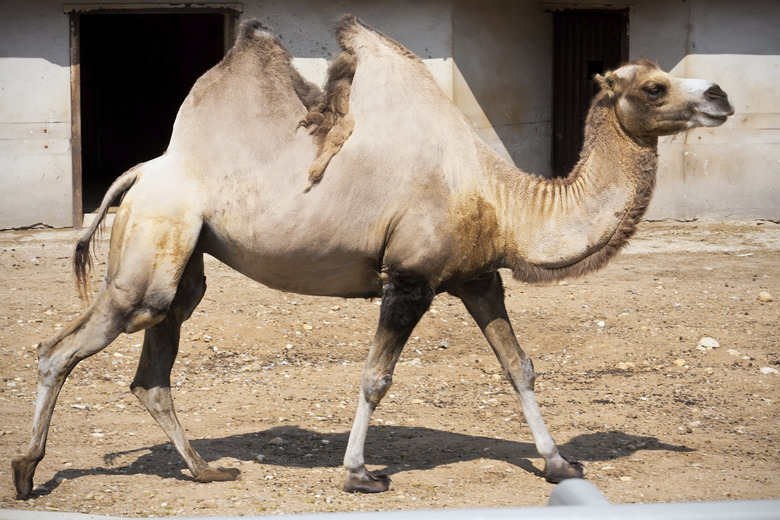What Is The Natural Habitat Of Camels?
No large mammal is more closely associated with desert habitats than the camel. These gangly, humped hoofed mammals (or ungulates) exist today as three species: two are the domesticated Bactrian camel (Camelus bactrianus) and wild Bactrian camel (Camelus ferus), which evolved on the arid and semiarid steppes of central Asia. The third camel species is the dromedary or Arabian camel (Camelus dromedarius), which likely arose in the deserts of the Arabian Peninsula. From salty basins and stony, wind-scoured plains to soaring sand dunes, camels exhibit a variety of adaptations to their harsh environments. These adaptations have made them among the most important beasts of burden across large areas of Asia and North Africa.
Introducing the Camels
Introducing the Camels
The Old World camel species have distant relatives in South America in the form of llamas, alpacas and guanacos. These are cousins in the larger camelid family (Camelidae), which actually originated in North America some 40 million years ago. True camels split from New World camelids between 11 to 25 million years ago, and dromedaries and Bactrian camels diverged perhaps four to five million years ago. Wild and domesticated Bactrians, meanwhile, may have gone their separate evolutionary ways 700,000 or so years ago. Humans domesticated Bactrian camels in central Asia roughly 6,000 years ago and tamed dromedaries in the Middle East within a couple of thousand years after that.
The dromedary sports a single hump, while the two Bactrian camels are double-humped. Dromedaries, by far the most numerous camel, range in domesticated form across large swaths of southwestern Asia, the Middle East, and North Africa; a significant feral (free-ranging) population occupies the Australian interior. Domesticated Bactrian camels are widespread in Central Asia, while the wild Bactrian camel – among the most endangered large mammals in the world, and the only truly wild camels anywhere – clings to existence in a few remnant populations in the Gobi and Taklamakan deserts of northwestern China and southwestern Mongolia.
“Ships of the Desert”: The Camel’s Dryland Adaptations
"Ships of the Desert": The Camel's Dryland Adaptations
Camel habitat takes a variety of specific forms, from the stony uplands of the Gobi desert to the dune seas of Arabia and the Sahara. The animals' hardiness in barren deserts and arid steppes helps explain why they were eagerly exploited as livestock; their ability to haul humans and cargo across inhospitable terrain earned them the label "ships of the desert." A range of adaptations explain camels' success in these demanding environments.
The camel's two toes spread to support the animal's weight on sand, a feature enhanced in the dromedary by especially broad hoof pads. Long camel eyelashes trap windblown sand. Camels can go without water for long stretches – obtaining moisture from food and rehydrating quickly and efficiently at water sources – and persist on scarce, widely scattered and low-quality forage by storing fat in their humps. Wild Bactrian camels in the Lop Nur region of China survive by drinking highly saline (salt-rich) freshwater – even saltier, according to the Wild Camel Protection Foundation, than what domesticated Bactrian camels can subsist on.
Camels can endure high body temperatures without sweating (a form of water loss). But it's not just scorching heat these ungulates contend with. Bactrian camels also face severe cold in central Asian deserts and dry steppes. They grow a thick woolly coat during winter and shed it in summer, helping them deal with annual temperatures that may swing from -30 degrees Fahrenheit to well over 100 degrees Fahrenheit.
Camels on the Move
Camels on the Move
The ability to go without food or water for extended periods, coupled with those long, knobby legs, allows camels to cover a lot of ground – this is a critical adaptation in arid, sparsely vegetated environments requiring them to travel long distances between far-flung water sources and browse. A study on wild camels in Mongolia's Gobi Desert showed that, while the average daily straight-line distances that camels covered ranged from about two to four miles, at least one animal hoofed it some 46 miles in a mere 21 hours.
Feral Camel Habitat Impacts in Australia
Feral Camel Habitat Impacts in Australia
Humans imported dromedaries to Australia beginning in about 1840 and used them widely as pack animals into the early 20th century. Releases of domesticated dromedaries in the 1920s and '30s led to the establishment of today's significant feral population of camels in interior Australia. Perhaps a million feral camels roam the Australian Outback, with the highest densities in the Great Sandy and Simpson deserts. Taking quite well to Australia's "Red Center" – not all that different from their ancestral drylands – these camels now exist as the only significant stock of free-ranging dromedaries in the world.
Studies suggest these feral camels may be having a significant environmental impact on Australia's arid and semi-arid ecosystems. Areas with significant camel browsing show significant breakage and stunting among shrubs such as umbrella bush, plumbush and horse mulga, while dromedary-fouled waterholes show reduced water quality and aquatic biodiversity.
Cite This Article
MLA
Shaw, Ethan. "What Is The Natural Habitat Of Camels?" sciencing.com, https://www.sciencing.com/natural-habitat-camels-6686152/. 30 September 2021.
APA
Shaw, Ethan. (2021, September 30). What Is The Natural Habitat Of Camels?. sciencing.com. Retrieved from https://www.sciencing.com/natural-habitat-camels-6686152/
Chicago
Shaw, Ethan. What Is The Natural Habitat Of Camels? last modified August 30, 2022. https://www.sciencing.com/natural-habitat-camels-6686152/
